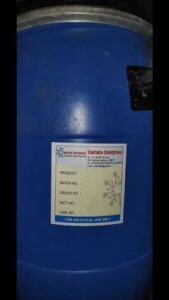Yarn Oil Product Description
Yarn oil is a specialized lubricant used in the textile industry, particularly in the spinning and weaving processes. It is designed to enhance the performance of yarns by reducing friction, preventing breakage, and improving the overall quality of the fabric produced. Yarn oil is typically formulated with a blend of mineral oils, additives, and emulsifiers to provide optimal lubrication and protection for the fibers. This product is essential for ensuring smooth operation of machinery and achieving high-quality textile outputs.
Uses of Yarn Oil
- Lubrication: Reduces friction between yarn and machine components, minimizing wear and tear.
- Protection: Forms a protective layer on the yarn, preventing damage from environmental factors.
- Improved Yarn Quality: Enhances the smoothness and strength of the yarn, leading to better fabric quality.
- Dust and Static Control: Helps in controlling dust and static electricity, which can affect the spinning process.
- Compatibility: Suitable for various types of fibers, including cotton, polyester, and blends.
Technical Data
| Property | Specification |
|---|---|
| Appearance | Clear to slightly yellow liquid |
| Viscosity (cSt at 40°C) | 20 – 30 |
| Density (g/cm³) | 0.85 – 0.90 |
| Flash Point (°C) | > 150 |
| pH | 6.5 – 7.5 |
| Solubility | Soluble in water (emulsifiable) |
| Recommended Dosage | 0.5 – 2.0% based on fiber weight |
| Storage Conditions | Store in a cool, dry place away from direct sunlight |
Key Benefits
- Enhanced Performance: Yarn oil improves the efficiency of textile machinery, leading to higher production rates.
- Cost-Effective: Reduces maintenance costs by prolonging the life of machinery and reducing downtime.
- Versatile Application: Can be used in various stages of yarn processing, from spinning to weaving.
- Eco-Friendly Options: Many yarn oils are now available with biodegradable formulations, catering to environmentally conscious manufacturers.
In summary, yarn oil is a crucial component in the textile industry, providing lubrication, protection, and quality enhancement for yarns. Its technical specifications ensure that it meets the demands of modern textile manufacturing processes.

